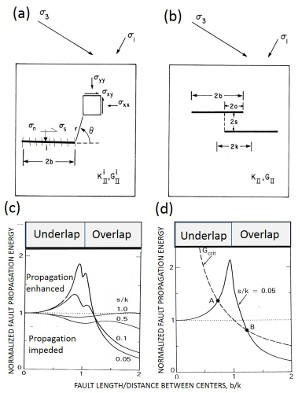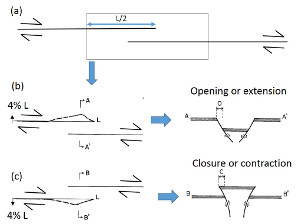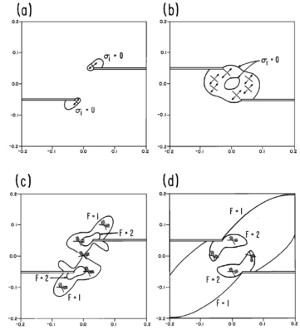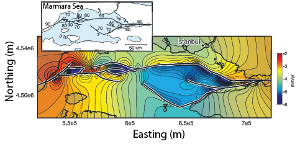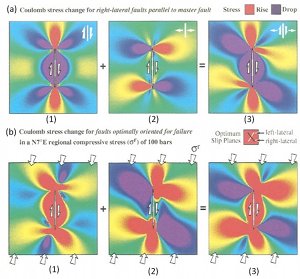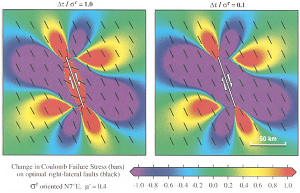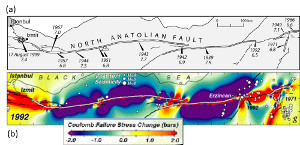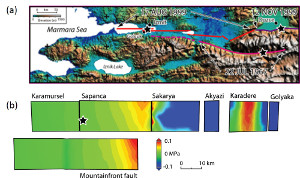| |||||||
|
|
|||||||
|
|
|||||||
| Interaction of Faults | |||||||
|
Faults are associated with perturbed stresses which vary spatially. This variation is the largest around the periphery (tips in 2D) of faults and drops down to the background values away from the fault at a distance which is proportional to the fault length. Examples of stress distributions around idealized single faults are given under the link, 'Fracture Mechanics.' Presence of other faults or fractures within the regions of the perturbed stresses facilitates interaction between them and the master fault. The nature of this interaction depends on the spatial distribution of these structures with respect to each other, their orientation, and the remote loading. Field evidence of fault interactions has been well documented. Among these are the dimensional properties of the echelon geometry of faults and how they are controlled by fault interaction. It is intriguing that fault overlaps are proportional to the fault separation (Aydin and Schultz, 1990). This has been analyzed using a displacement discontinuity model (Figure 1) originally developed by Crouch (1976) and Crouch and Starfield (1983). Figure 1 shows a summary of the results from this analysis: The interaction is important if the faults are closely spaced and their tips are closer as shown in Figure 1(c) for frictionless faults and Figure 1(d) for a pair of echelon faults with moderate friction coefficient of 0.6. The interaction also influences the dilation or contraction of fault zones as illustrated in Figure 2 (Aydin et al. 1990). For example, fault interaction produces opening along the overlapping parts of the fault within dilational steps (Figures 2a, b, and c) and contraction within the contractional steps (Figures 2c and d). The dilation and contraction within the fault zones may manifest themselves in different ways depending on the rock rheology. It is possible that the dilation may be localized along the fault zone as simple opening or by a distributed shearing. The occurrence of pull-apart and pushup structures are well known, particularly in strike-slip fault environments (Aydin and Nur, 1982). This has been attributed to the concentration of extension for pull-aparts and contraction for pushups (Figures 3a, b) due to increasing tensile stresses and lower mean stresses at pull-aparts, and compressive stresses and increasing compressive mean stresses at push-ups. Although distribution of tensile and contraction stresses at the corresponding quadrants of single faults also occurs, the interaction of the neighboring faults or fault segments amplifies the magnitudes and the area of influences of these perturbations. The specific structure types around the echelon faults are variable. Segal and Pollard (1980) calculated the orientations and distributions of the principal stresses, maximum shear stresses, and mean stresses associated with the interacting echelon strike-slip faults. Although the dominant secondary structures that these authors considered were joints associated with mode-II fractures readily applied to strike-slip faults (Figure 4), it is possible that under different boundary conditions and rock behavior, normal or thrust faults may form at the stepover regions of echelon strike-slip faults. Perhaps the clearest manifestation of the extension at pull-apart basins is the subsidence due to the vertical component of the surface deformation. Figure 5 illustrates one of the spectacular examples from the Marmara Sea basin along the North Anatolian Fault (Muller and Aydin, 2005). Here, the surface morphology of the three basins are determined using fault geometry proposed by Armijo et al. (2002) among others. The model boundary conditions are based on the distribution and direction of the slip on the bounding faults related to the right-lateral plate boundary motion. The model results match reasonably well the bathymetry and the available seismic data from the basin. Please see the 'Echelon Faults' link for these products and interaction of faults with different kinematics. Perhaps the most convincing examples of fault interaction come from earthquake seismology. The diagrams in Figure 6 show a vertical fault in half space or map view of a strike-slip fault and changes of various stresses after the failure of the fault (King et al., 1984). They illustrate the concept by analyzing Coulomb stress change across planes parallel to the master strike-slip fault. Figures 6(a-1) and 6(a-2) show right-lateral shear stress change and the product of effective friction times normal stress change, respectively, as increases (rise) and decreases (drop). Figure 6(a-3) shows the right-lateral Coulomb stress change which is the product of the two in (a-1) and (a-2). The three diagrams in Figure 6(b) show the same changes (b-1, b-2, b-3) for faults with the same right-lateral sense optimally oriented for failure under a regional compression of 100 bars rotated 7 degrees clockwise from the orientation of the master fault. Notice how the lobes of stress increases and decreases differ from those in Figure 6(a-1, a-2, a-3). Figure 7 from the same authors includes two diagrams to show the dependence of the Coulomb stress change on the regional stress magnitude; one with the total stress drop or total stress release (left panel) and another with only ten percent of stress drop (right panel). Note that the optimal orientation of right-lateral faults becomes sub-parallel to the master fault in the small stress drop case. The best case study for fault interaction comes from the westward earthquake progression along the North Anatolian Fault, which has been known for some time. Stein et al. (1997) coined the 'stress triggering mechanism' for this remarkable sequence of seismic ruptures which started with the 1939 Erzincan earthquake and culminated with the 1999 Izmit Kocaeli earthquake (Figure 8a). Figure 8(b) shows the cumulative Coulomb Failure Stress change since the 1939 Erzincan earthquake until the 1999 Izmit earthquake along the North Anatolian Fault using sequential earthquake slip distribution in an elastic half-space model (from Stein et al., 1997). Figure 9(a) is the map of the surface rupture of the 1967 Mudurnu Valley earthquake and Figure 9(b) shows the calculated stress changes due to the earthquake prior to the 1999 Izmit earthquake using a 3-D boundary element method (Muller et al. 2003) supporting the stress triggering notion from one of the most recent earthquake sequences along the North Anatolian Fault. | |||||||
| Types of Interaction of Faults: | |||||||
| Material RotationFault Segment Linkage | |||||||
| Reference: |
|||||||
| Armijo, R., Meyer, B., Navarro, S., King, G.C.P., Barka, A., 2002 Aydin, A., Schultz, R.A., 1990 King, G.C.P., Stein, R.S., Lin, J., 1984 Muller, J.R., Aydin, A., Maerten, F., 2003 Muller, J.R., Aydin, A., 2005 Segall, P., Pollard, D.D., 1980 Stein, R.S., Barka, A., Dieterich, J.H., 1997 |
|||||||
|
Readme | About Us | Acknowledgement | How to Cite | Terms of Use | Ⓒ Rock Fracture Knowledgebase |
|||||||
